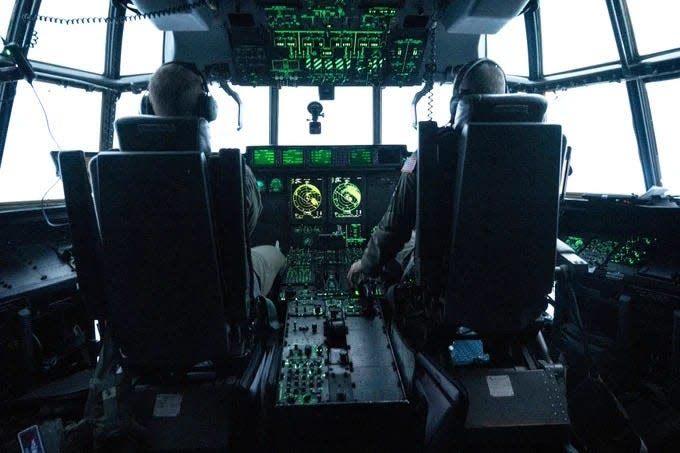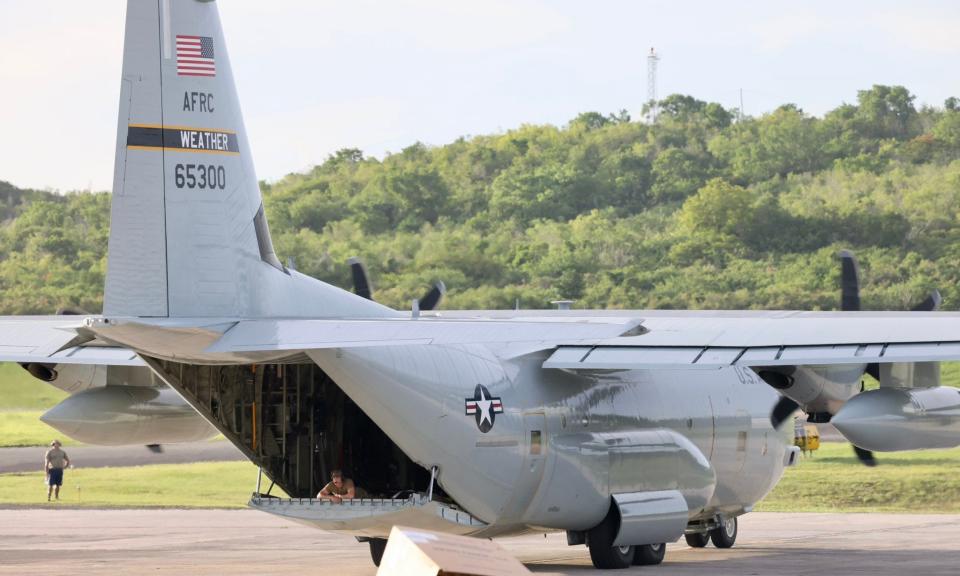Want to fly into Hurricane Lee? No? Video shows Hurricane Hunters enter eye of Cat 5 storm
As residents keep a wary eye on the Hurricane Lee, regularly calling up spaghetti models and forecast paths, another group of people are getting up close and personal with the powerful storm that hit Category 5 status overnight.
They're known as the Hurricane Hunters.
Earlier this morning, they tweeted video and photos from their flight into the eye of what was then a Category 5 hurricane.
Will Hurricane Lee impact Florida? See spaghetti models, track path and storm activity
The Hurricane Hunters have been busy. They were flying around the clock the end of August, "flying Tropical Storm Hilary in the Pacific and Hurricanes Franklin and Idalia in the Atlantic and the Caribbean to improve National Hurricane Center forecasts."
Who are the Hurricane Hunters?

The 53rd Weather Reconnaissance Squadron, a component of the 403rd Wing, make up the Hurricane Hunters.
It's a "one-of-a-kind organization," and "is the only operational unit in the world flying weather reconnaissance on a routine basis," according to their website.
They're based out of Keesler Air Force Base in Biloxi, Mississippi.
What is the mission of the Hurricane Hunters?
"The mission of the Hurricane Hunters is to recruit, organize and train assigned personnel to perform aerial weather reconnaissance.
"They provide surveillance of tropical storms and hurricanes in the Atlantic Ocean, the Caribbean Sea, the Gulf of Mexico and the central Pacific Ocean for the National Hurricane Center in Miami."
Hurricanes aren't the only storms the team flies. They also fly winter storm missions off both coasts of the United States.
Who makes up a crew on a Hurricane Hunter flight?
The 53rd Weather Reconnaissance Squadron is made up of 20 air crews. Fifty-nine hold air reserve technician positions. The rest of the squadron is made up of Air Force Reservists.
Each flight carries a basic crew of five: pilot, co-pilot, navigator, flight meteorologist and weather reconnaissance loadmaster.
The pilot, who serves as the aircraft commander, and the co-pilot man the flight controls.
The navigator keeps track of the aircraft's position and movement and monitors radar to avoid tornadic activity.
The flight meteorologist acts as flight director and observes and records meteorological data at flight level using a computer that encodes weather data every 30 seconds.
The weather reconnaissance loadmaster collects and records vertical meteorological data using a parachute-borne sensor known as a dropsonde.
What kind of plane do the Hurricane Hunters use?

Lockheed Martin describes the WC-130J as the world’s most powerful meteorologist.
"The WC-130J is configured with palletized weather instrumentation for penetration of tropical disturbances and storms, hurricanes and winter storms to obtain data on movement, size and intensity," according to Lockheed Martin.
"There are only minor differences between the Hurricane Hunter aircraft and any other C-130J. Operated by U. S. Air Force Reserve Command, the WC-130J usually penetrates hurricanes at an altitude of approximately 10,000 feet to collect meteorological data in the vortex, or eye, of the storm. The data collected by the WC-130J makes the advance warning of hurricanes possible and increases the accuracy of hurricane predictions and warnings by as much as 30 percent."
Details of the WC-130J
Speed: 417 mph
Range: 1,841 miles with payload
National Hurricane Center: Forecast path and maximum sustained winds of Hurricane Lee

Special note on the NHC cone: The forecast track shows the most likely path of the center of the storm. It does not illustrate the full width of the storm or its impacts, and the center of the storm is likely to travel outside the cone up to 33% of the time.
Latest spaghetti models for Hurricane Lee
Special note about spaghetti models: Illustrations include an array of forecast tools and models, and not all are created equal. The hurricane center uses only the top four or five highest performing models to help make its forecasts.
Satellite photos of Hurricane Lee, views from Hurricane Hunters
This article originally appeared on Treasure Coast Newspapers: Hurricane Hunters: Who are they, why do they fly into storms? Video

